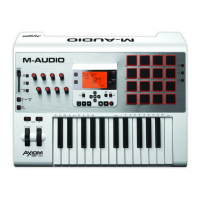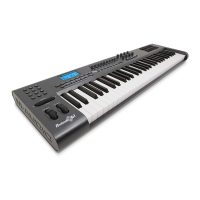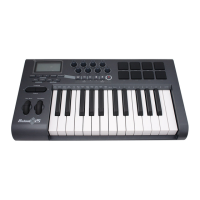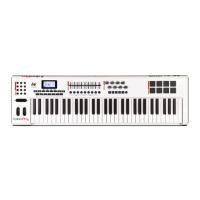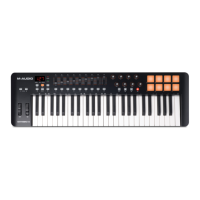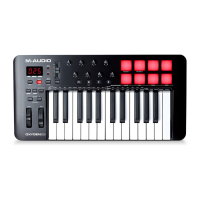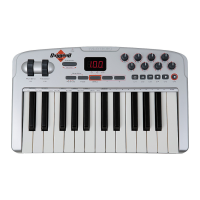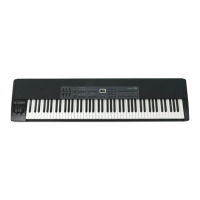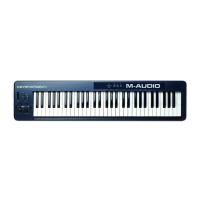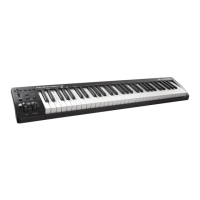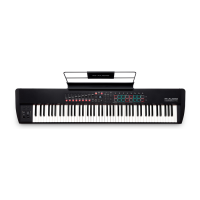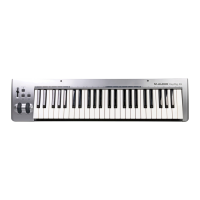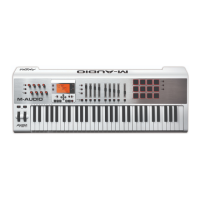
Do you have a question about the M-Audio Axiom AIR 61 and is the answer not in the manual?
| MIDI-keyboard number of keys | 61 keys |
|---|---|
| Product color | Black, White |
| Interface | USB |
| DC-in jack | Yes |
| USB ports quantity | 1 |
| Windows operating systems supported | Windows 7 Enterprise, Windows 7 Enterprise x64, Windows 7 Home Basic, Windows 7 Home Basic x64, Windows 7 Home Premium, Windows 7 Home Premium x64, Windows 7 Professional, Windows 7 Professional x64, Windows 7 Starter, Windows 7 Starter x64, Windows 7 Ultimate, Windows 7 Ultimate x64, Windows 8, Windows 8 Enterprise, Windows 8 Enterprise x64, Windows 8 Pro, Windows 8 x64, Windows Vista Business, Windows Vista Business x64, Windows Vista Enterprise, Windows Vista Enterprise x64, Windows Vista Home Basic, Windows Vista Home Basic x64, Windows Vista Home Premium, Windows Vista Home Premium x64, Windows Vista Ultimate, Windows Vista Ultimate x64, Windows XP Home, Windows XP Professional |
| Power source type | DC |
| Depth | 381 mm |
|---|---|
| Width | 972 mm |
| Height | 102 mm |
| Weight | 6840 g |
Lists all included hardware and software items in the Axiom AIR 61 package.
Information for system requirements, driver downloads, and M-Audio support.
Guidance on installing Pro Tools Express, Ignite, and HyperControl software.
Step-by-step initial setup for connecting and powering on the Axiom AIR.
Diagram of a basic setup with audio interface and monitors.
Diagram illustrating a setup using headphones.
Diagram for a setup involving a USB mixer and external synth.
Describes the velocity-sensitive keyboard for expressive performance.
Explains LCD, Edit, Tempo, Identify, Memory, Transport, and Directional buttons.
Overview of knobs and faders for mixing and plug-in parameter control.
Describes pads for drum parts, samples, and software features.
In-depth explanation of knob and fader functions in different modes.
Details functions of fader buttons and usage of trigger pads.
Detailed description of the main control panel elements.
Identifies and explains all ports and connections on the rear of the unit.
Explains Pad Learn and Pad Roll modes for trigger pads.
How to map Axiom AIR controls to MIDI messages for custom setups.
Step-by-step process for assigning MIDI messages to physical controls.
How to choose MIDI message types and parameters for output.
Tool to identify which software parameter a hardware control is linked to.
How to select and customize keyboard and pad velocity curves.
How to set the default MIDI channel for all transmissions.
How to configure the primary MIDI output port.
How to send an "All Notes Off" message to clear stuck notes.
Procedures for saving and loading MIDI assignment presets.
Using SysEx to back up and restore all memory locations.
Initial setup and testing for HyperControl integration with DAWs.
How to use Axiom AIR's transport controls with DAW software.
Using HyperControl for software mixing functions.
Using HyperControl to adjust plug-in parameters.
Details on Directional buttons and Trigger Pads in HyperControl.
How to verify control assignments in HyperControl or custom modes.
Using Axiom AIR to control Ignite's transport, navigation, and instruments.
Details MIDI CC, RPN, NRPN messages for controls like knobs and faders.
MIDI CC, RPN, NRPN, Program Change, and button behavior settings.
MIDI CC, RPN, NRPN, and MMC message types for transport controls.
